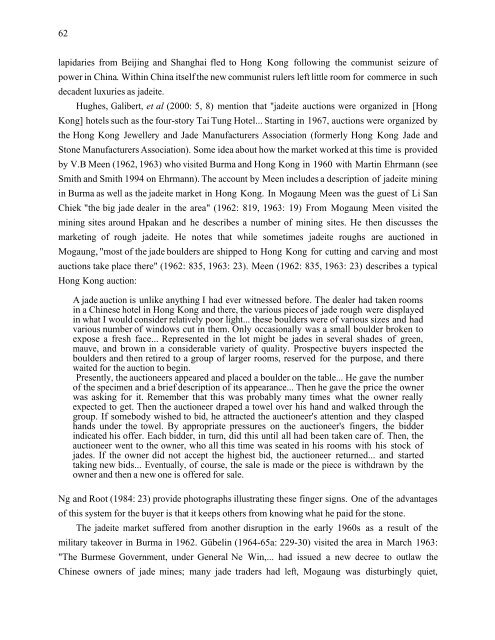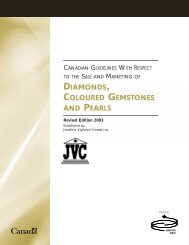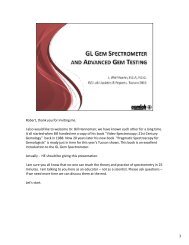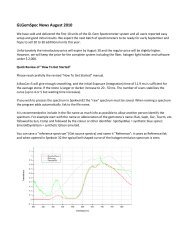JADEITE - Canadian Institute of Gemmology
JADEITE - Canadian Institute of Gemmology
JADEITE - Canadian Institute of Gemmology
You also want an ePaper? Increase the reach of your titles
YUMPU automatically turns print PDFs into web optimized ePapers that Google loves.
62<br />
lapidaries from Beijing and Shanghai fled to Hong Kong following the communist seizure <strong>of</strong><br />
power in China. Within China itself the new communist rulers left little room for commerce in such<br />
decadent luxuries as jadeite.<br />
Hughes, Galibert, et al (2000: 5, 8) mention that "jadeite auctions were organized in [Hong<br />
Kong] hotels such as the four-story Tai Tung Hotel... Starting in 1967, auctions were organized by<br />
the Hong Kong Jewellery and Jade Manufacturers Association (formerly Hong Kong Jade and<br />
Stone Manufacturers Association). Some idea about how the market worked at this time is provided<br />
by V.B Meen (1962, 1963) who visited Burma and Hong Kong in 1960 with Martin Ehrmann (see<br />
Smith and Smith 1994 on Ehrmann). The account by Meen includes a description <strong>of</strong> jadeite mining<br />
in Burma as well as the jadeite market in Hong Kong. In Mogaung Meen was the guest <strong>of</strong> Li San<br />
Chiek "the big jade dealer in the area" (1962: 819, 1963: 19) From Mogaung Meen visited the<br />
mining sites around Hpakan and he describes a number <strong>of</strong> mining sites. He then discusses the<br />
marketing <strong>of</strong> rough jadeite. He notes that while sometimes jadeite roughs are auctioned in<br />
Mogaung, "most <strong>of</strong> the jade boulders are shipped to Hong Kong for cutting and carving and most<br />
auctions take place there" (1962: 835, 1963: 23). Meen (1962: 835, 1963: 23) describes a typical<br />
Hong Kong auction:<br />
A jade auction is unlike anything I had ever witnessed before. The dealer had taken rooms<br />
in a Chinese hotel in Hong Kong and there, the various pieces <strong>of</strong> jade rough were displayed<br />
in what I would consider relatively poor light... these boulders were <strong>of</strong> various sizes and had<br />
various number <strong>of</strong> windows cut in them. Only occasionally was a small boulder broken to<br />
expose a fresh face... Represented in the lot might be jades in several shades <strong>of</strong> green,<br />
mauve, and brown in a considerable variety <strong>of</strong> quality. Prospective buyers inspected the<br />
boulders and then retired to a group <strong>of</strong> larger rooms, reserved for the purpose, and there<br />
waited for the auction to begin.<br />
Presently, the auctioneers appeared and placed a boulder on the table... He gave the number<br />
<strong>of</strong> the specimen and a brief description <strong>of</strong> its appearance... Then he gave the price the owner<br />
was asking for it. Remember that this was probably many times what the owner really<br />
expected to get. Then the auctioneer draped a towel over his hand and walked through the<br />
group. If somebody wished to bid, he attracted the auctioneer's attention and they clasped<br />
hands under the towel. By appropriate pressures on the auctioneer's fingers, the bidder<br />
indicated his <strong>of</strong>fer. Each bidder, in turn, did this until all had been taken care <strong>of</strong>. Then, the<br />
auctioneer went to the owner, who all this time was seated in his rooms with his stock <strong>of</strong><br />
jades. If the owner did not accept the highest bid, the auctioneer returned... and started<br />
taking new bids... Eventually, <strong>of</strong> course, the sale is made or the piece is withdrawn by the<br />
owner and then a new one is <strong>of</strong>fered for sale.<br />
Ng and Root (1984: 23) provide photographs illustrating these finger signs. One <strong>of</strong> the advantages<br />
<strong>of</strong> this system for the buyer is that it keeps others from knowing what he paid for the stone.<br />
The jadeite market suffered from another disruption in the early 1960s as a result <strong>of</strong> the<br />
military takeover in Burma in 1962. Gübelin (1964-65a: 229-30) visited the area in March 1963:<br />
"The Burmese Government, under General Ne Win,... had issued a new decree to outlaw the<br />
Chinese owners <strong>of</strong> jade mines; many jade traders had left, Mogaung was disturbingly quiet,









